Статьи журнала - International Journal of Image, Graphics and Signal Processing
Все статьи: 1056
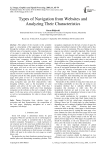
Types of navigation from websites and analyzing their characteristics
Статья научная
The subject of the research in this scientific paper is a description of the opportunity for navigation through the websites, with special emphasis on analyzing different types of navigation systems. The important part of my paper is analyzing the characteristics of various navigation structures on the web pages, as well as the analyzing technical methods of displaying navigation on various users' computers. In addition, users can have different browsers, different operating systems, and different preferences in terms of their computers' settings. All these technical issues will have an impact on how the web pages will look on the user's computer. Another thing described in my work is the interpretation of navigation structures on the user's computer monitor. A special overview is made for the correlation between web navigation and all the other graphic elements in the web pages from point of view of a visual harmony of the websites. Additionally, here I give overall directions for using navigation type and their characteristics when designing websites, same as the description of some opinions and advice on the same topic. After that, I analyze twelve problems which arise from displaying navigation on the websites on the user's computer. In this paper, I will come across a few solutions for all of them, as well as recommendations for when to choose which solution.
Бесплатно
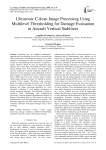
Статья научная
Following the "on condition maintenance" approach used for extending service life of an aircraft one of the major tasks is a nondestructive testing of its critical elements. Considering that many of elements of operated aircraft are manufactured from polymeric composites a special attention should be paid for diagnosing these elements due to their high vulnerability to barely visible impact damage. One of the primary testing techniques used for inspection of aircraft composite elements is an ultrasonic C-Scan technique which application results in planar images of emitted/received wave attenuation and a time of flight map. Due to the complex nature of barely visible impact damage occurrence it is difficult to analyze resulting C-Scan images. Therefore, using assistance based on image processing may help with "big–data" analysis of collected images. In this paper the authors proposed the image processing algorithm for semi-automatic evaluation of such damage distribution in aircraft composite structures. The algorithm is based on multilevel Otsu thresholding and morphological processing. Using the proposed algorithm an extraction of damage visualization from a C-Scan image as well as its characterization and 3D representation is possible. The developed approach will allow supporting diagnosing of composite structures with impact damage using C-Scan technique.
Бесплатно
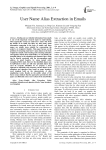
User Name Alias Extraction in Emails
Статья научная
Finding out user identity information from emails is one of the important research topics in email mining. Most approaches extract an email user’s name only from the header of an email, but there are often many name information appearing in the body of emails, and those names are usually more suitable for representing the sender’s or recipient’s identity. This paper focuses on the problem of extracting email users’ name aliases in the body of plain-text emails. After locating and extracting salutation and signature blocks from email bodies, we can identify the potential aliases in the salutation and signature lines, which can be directly associated with the corresponding email address in email headers, by using named entity recognition(NER) tools. However the identified aliases may be half-baked or there are still some potential aliases that can’t be correctly identified. So we propose a novel approach to efficiently and accurately extract aliases in the salutation and signature lines based on name boundary word template built on the characteristics of alias neighboring words. Results on the public subset of the Enron corpus indicate that the approaches presented in this paper can efficiently extract user’s aliases from email bodies.
Бесплатно
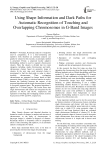
Статья научная
Nowadays, Karyotype analysis is frequently used in cytogenetics. It is a time-consuming and repetitive work therefore an automatic analysis can greatly be valued. In this research, an automatic method is presented. Firstly, a proposed locally adaptive thresholding method is used to segment chromosome clusters. Then, the clusters is divided into two main categories including, single chromosomes and multi-chromosome clusters based on geometric shape of clusters. In the next step, each extracted cluster is investigated to find the dark paths in order to detect touching chromosomes. Then, overlapping chromosomes are separated in clusters based on their geometric shapes. Finally, a criterion function is used to measure the similarity between the outputs of the proposed algorithm and the single chromosomes in order to recognize separated parts. The proposed algorithm is applied on 47 G-band images. The results shows that single chromosomes and clusters are recognized by the precision of 98.5% and 86.4%, respectively and separation of touching and overlapping clusters are done by precision of 70% and 67%, respectively.
Бесплатно
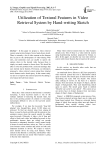
Utilization of Textural Features in Video Retrieval System by Hand-writing Sketch
Статья научная
In this paper we propose a video retrieval system using texture features from a hand-drawn sketch. There is currently a lot of video content on the Internet due in part to the development of video-sharing Web sites, and sometimes users are unable to narrow the options down to the desired video because there is simply too much content to choose from. We should be able to solve this problem with a retrieval technique that uses internal movie features. Previously, our laboratory proposed a video retrieval system using three internal movie features and a sketch query. In the current study, our aim is to improve the retrieval precision by adding a new feature derived from texture.
Бесплатно
Utilizing GVF Active Contours for Real-Time Object Tracking
Статья научная
In this paper an object tracking system with utilizing optical flow technique, and Gradient Vector Flow (GVF) active contours is presented. Optical flow technique is less sensitive to background structure and does not need to build a model for the background of image so it would need less time to process the image. GVF active snakes have good precision for image segmentation. However, due to the high computational cost, they are not usually applicable. Since precision and time complexity are the most important factors in the image segmentation, several methods have been developed to overcome these problems. In this paper, we, first, recognize the moving object. Then, the object fame with some pixels surrounding to it, was created. Then, this new frame is sent to the GVF filed calculation procedure. Contour initialization is obtained based on the selected pixels. This approach increases the calculation speed, and therefore makes it possible to use the contour for the tracking. The system was built, and tested with a microcomputer. The results show a speed of 10 to 12 frames per second which is considerably suitable for object tracking approaches.
Бесплатно
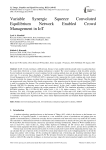
Variable Synergic Squeeze Convoluted Equilibrium Network Enabled Crowd Management in IoT
Статья научная
In IoT, Crowd counting is a difficult task, because of any sudden incidents people unites in a particular place. To count them effectively a crowd counting mechanism is needed. The crowd counting is help for public security. Several methods are proposed for crowd counting, but the existing methods does not provide high accuracy and high error rate. To overcome these drawbacks a Variable Synergic Squeeze Convoluted Equilibrium Network Enabled Crowd Management in IoT (VS2CEN-CC-IOT) is proposed in this manuscript for crowd counting and crowd density detection. Initially, the images are taken from two datasets named ShanghaiTech and Venice dataset. Then the images are preprocessed using Gaussian filter based preprocessing. After preprocessing the discrete wavelet transform (DWT) is used for extracting the features. The extracted features are then given to Synergic Squeeze Convoluted Equilibrium Network (SSCEN) for detecting crowd count and crowd density. In this work, variable Equilibrium Optimization Algorithm (EOA) is applied to optimize the weight parameter of SSCEN. The simulation procedure is performed in PYTHON platform. The VS^2CEN-CC-IOT attains 0.8%, 1.3%, 1.5% higher accuracy, 13%, 3.3%, 8.2% higher Precision, 12%, 10%, 17% higher specificity , 8.2%, 3.3%, 6.9% higher F1-score and 0.12%, 0.06%, 0.07% lower mean absolute error (MAE), 0.2%, 0.25%, 0.1% lower root mean square error than the existing optimization approaches such as Arithmetic Optimization Algorithm(ADA), Chaos Game Optimization(CGO) and Gradient Based Optimizer(GBO) respectively.
Бесплатно
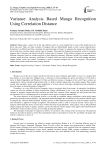
Variance Analysis Based Mango Recognition Using Correlation Distance
Статья научная
Mango plays a major role in the Agro industry and it is a very popular fruit to most of the people due to its flavor and taste. There are many varieties of mangoes that are differentiable based on their various characteristics. Sometimes it is difficult and time consuming for general people or farmers to categorize the mango into different types due to intra-class variation among various types of mangoes. This paper has proposed an automatic system to recognize mangoes thus it becomes convenient to identify various types of mangoes. In this method, mangoes are recognized into different categories based on variance analysis or data dispersion measures. Measures include five number summary, variance, mean deviation, skewness, coefficient of variation which are used as features. From both training and query images, feature vectors are created. Correlation is used to recognize mangoes into various categories. The proposed method shows better result than some existing methods.
Бесплатно
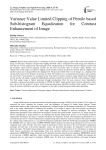
Статья научная
Digital image enhancement is a technique to process a digital image to improve the overall visual quality of image. In this paper, Variance concept based clipping threshold value is computed from input image pixel intensity to limit the rate of over enhancement. The histogram of the original image is sub-divided into five adjacent sections and the boundary values between adjacent sections are put from the penile value of intensity range. Besides, over enhancement of the image is avoided by clipping certain number of pixels having more intensity than the clipping limit and these pixels are rearranged below the clipping limit. The present method offers two advantages viz., clipping of the certain pixels based on the property of the data set itself. The another one is to histogram processing by parts and this has given better visual quality, low computation time with improved metrics related to image enhancement. Histogram of each specific sub-image is equalized independently and then combined to produce the final contrast enhanced image. The final output image is further processed through imreducehaze filter for more improve result. Quantitative evaluation of proposed algorithm is performed by CPCQI and QILV image quality metrics and the simulation results have shown that the proposed variance based histogram equalization algorithm produces better quality of image in terms of contrasts, brightness and color in comparison to the other existing histogram equalization algorithms.
Бесплатно
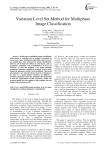
Variation Level Set Method for Multiphase Image Classification
Статья научная
In this paper a multiphase image classification model based on variation level set method is presented. In recent years many classification algorithms based on level set method have been proposed for image classification. However, all of them have defects to some degree, such as parameters estimation and re-initialization of level set functions. To solve this problem, a new model including parameters estimation capability is proposed. Even for noise images the parameters needn’t to be predefined. This model also includes a new term that forces the level set function to be close to a signed distance function. In addition, a boundary alignment term is also included in this model that is used for segmentation of thin structures. Finally the proposed model has been applied to both synthetic and real images with promising results.
Бесплатно
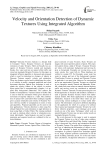
Velocity and orientation detection of dynamic textures using integrated algorithm
Статья научная
Dynamic Texture Analysis is a hotspot field in Computer Vision. Dynamic Textures are temporal extensions of static Textures. There are broadly two cat-egories of Dynamic Textures: natural and manmade. Smoke, fire, water and tree are natural while traffic and crowd are manmade Dynamic Textures. In this paper, an integrated efficient algorithm is discussed and proposed which is used for detecting two features of objects in Dynamic Textures namely, velocity and orientation. These two features can be used in identifying the velocity of vehicles in traffic, stampede prediction and cloud movement direction. Optical flow technique is used to obtain the velocity feature of the objects in motion. Since optical flow is computationally complex, it is applied after background subtraction. This reduces the number of computations. Variance feature of Gabor filter is used to find the orientation which gives direction of movement of majority objects in a video. The combination of optical flow and Gabor filter technique together gives accurate orientation and velocity of Dynamic Texture with less number of computations in terms of time and algorithm.. Proposed algorithm can be used in real time applications. Velocity detection is done using Farneback Optical flow and orientation or angle detection is done using Bank of Gabor Filters The existing methods are used to calculate either velocity or orientation accurately individually. Varied datasets are used for experimentation and acquired results are validated for the selected database.
Бесплатно
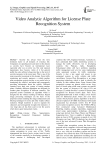
Video Analytic Algorithm for License Plate Recognition System
Статья научная
Security has always been the most dominant factor in all domains of everyday life. Companies are spending more and more in this domain as security have become an international issue especially after war on terror era. Not only national departments have become victim of it but general public has also suffered a huge deal due to the lack of security measures in the recent past. This is one of the main reasonfor investment in this domain. From traffic monitoring and security purposes, a vehicle number plate recognition system can play a very useful role in monitoring the vehicle’s movement and consequently providing information about the vehicle. Different countries have their own system of issuing number plates. Similarly different algorithms are designed for number plate recognition in different countries. The proposed system constitutes an algorithm which is designed for the vehicles residing in Pakistan. Digital image processing techniques are the basis of the proposed system including the image enhancement and filtering techniques for noise and other weather effects reduction. Hough transform is used to segment the characters and consequently recognize the character. A very large data set has been used to test the system which shows quite immaculate results.
Бесплатно
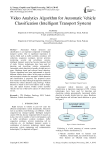
Video Analytics Algorithm for Automatic Vehicle Classification (Intelligent Transport System)
Статья научная
Automated Vehicle detection and classification is an important component of intelligent transport system. Due to significant importance in various fields such as traffic accidents avoidance, toll collection, congestion avoidance, terrorist activities monitoring, security and surveillance systems, intelligent transport system has become important field of study. Various technologies have been used for detecting and classifying vehicles automatically. Automated vehicle detection is broadly divided into two types- Hardware based and software based detection. Various algorithms have been implemented to classify different vehicles from videos. In this paper an efficient and economical solution for automatic vehicle detection and classification is proposed. The proposed system first isolates the object through background subtraction followed by vehicle detection using ontology. Vehicle detection is based on low level features such as shape, size, and spatial location. Finally system classifies vehicles into one of the known classes of vehicle based on size.
Бесплатно
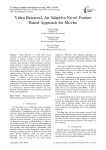
Video Retrieval: An Adaptive Novel Feature Based Approach for Movies
Статья научная
Video Retrieval is a field, where many techniques and methods have been proposed and have claimed to perform reliably on the videos like broadcasting of news & sports events. As a movie contains a large amount of visual information varying in random manner, it requires a highly robust algorithm for automatic shot boundary detection as well as retrieval. In this paper, we described a new adaptive approach for shot boundary detection which is able to detect not only abrupt transitions like hard cuts but also special effects like wipes, fades, and dissolves as well in different movies. To partition a movie video into shots and retrieve many metrics were constructed to measure the similarity among video frames based on all the available video features. However, too many features will reduce the efficiency of the shot boundary detection. Therefore, it is necessary to perform feature reduction for every decision. For this purpose we are following a minimum features based algorithm.
Бесплатно
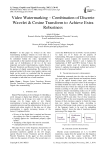
Video Watermarking – Combination of Discrete Wavelet & Cosine Transform to Achieve Extra Robustness
Статья научная
In this paper we worked on the video watermarking technique wherein we took video as a cover medium and some binary images as watermark to be embedded behind the video. Specifically we concentrated on the transform domain technique and we made use of hybridization of the two of the most important and useful transformations, namely Discrete Wavelet Transform and Discrete Cosine Transform, for the purpose of digital watermarking. We evaluated the proposed method with some visual quality matrices and based on the results we concluded that the proposed method provides extra robustness against various attacks as compare to individual use of each transform.
Бесплатно
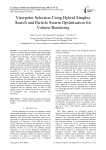
Viewpoint Selection Using Hybrid Simplex Search and Particle Swarm Optimization for Volume Rendering
Статья научная
In this paper we proposed a novel method of viewpoint selection using the hybrid Nelder-Mead (NM) simplex search and particle swarm optimization (PSO) to improve the efficiency and the intelligent level of volume rendering. This method constructed the viewpoint quality evaluation function in the form of entropy by utilizing the luminance and structure features of the two-dimensional projective image of volume data. During the process of volume rendering, the hybrid NM-PSO algorithm intended to locate the globally optimal viewpoint or a set of the optimized viewpoints automatically and intelligently. Experimental results have shown that this method avoids redundant interactions and evidently improves the efficiency of volume rendering. The optimized viewpoints can focus on the important structural features or the region of interest in volume data and exhibit definite correlation with the perception character of human visual system. Compared with the methods based on PSO or NM simplex search, our method has the better performance of convergence rate, convergence accuracy and robustness.
Бесплатно
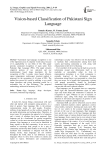
Vision-based Classification of Pakistani Sign Language
Статья научная
Automated sign language recognition is one of the important areas of computer vision today, because of its applicability in vast fields of life. This paper presents automated recognition of signs taken from Pakistani Sign Language (PSL). The paper presents empirical analysis of two statistical and one transformation based shape descriptors for the recognition of PSL. A purely vision based, efficient, signer independent, multi-aspect invariant method is proposed for the recognition of 44 signs of PSL. The method has proved its worth by utilizing a very small shape descriptor and giving promising results for a reasonable size of sign dictionary. The proposed methodology achieved an accuracy of 92%.
Бесплатно
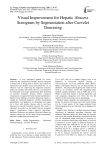
Visual Improvement for Hepatic Abscess Sonogram by Segmentation after Curvelet Denoising
Статья научная
A wise automated method for wisely improving the visualization of hepatic abscess sonogram, a modest trial is being done to denoise and reduce the ultrasound scan speckles wisely and effectively. As an effective way for improving the diagnostic decision; improved sonogram for hepatic abscess is reconstructed by ultrasound scan image segmentation after denoising in Curvelet transform domain. Better sonogram visualization is required for better human interpretation. Speckle noise filtering of medical ultrasound images is needed for enhanced diagnosis. Double thresholding segmentation was applied on, an ultrasound scan image for a Liver with amebic abscess, after it had been denoised in Curvelet transform domain. The result is enhanced wise effect on the hepatic abscess sonogram image's visualization which improves physicians' decisions. Moreover, this method effectively reduces the memory storage size for the image which consequently decreases computation processing time.
Бесплатно
Visual Object Target Tracking Using Particle Filter: A Survey
Статья научная
This paper gives the survey of the existing developments of Visual object target tracking using particle filter from the last decade and discusses the advantage and disadvantages of various particle filters. A variety of different approaches and algorithms have been proposed in literature. At present most of the work in Visual Object Target Tracking is focusing on using particle filter. The particle filters has the advantage that they deal with nonlinear models and non-Gaussian innovations, and they focus sequentially on the higher density regions of the state space, mostly parallelizable and easy to implement, so it gives a robust tracking framework, as it models the uncertainty and showing good improvement in the recognition performance compared to the kalman filter and other filters like Extended Kalman Filter (EKF), Unscented Kalman Filter (UKF).Various features and classifiers that are used with particle filter are given in this survey.
Бесплатно
Visual object tracking by fusion of audio imaging in template matching framework
Статья научная
Audio imaging can play a fundamental role in computer vision, in particular in automated surveillance, boosting the accuracy of current systems based on standard optical cameras. We present here a method for object tracking application that fuses visual image with an audio image in the template-matching framework. Firstly, an improved template matching based tracking is presented that takes care of the chaotic movements in the template-matching algorithm. Then a fusion scheme is presented that makes use of deviations in the correlation scores pattern obtained across the individual frame in each imaging domain. The method is compared with various state of art trackers that perform track estimation using only visible imagery. Results highlight a significant improvement in the object tracking by the assistance of audio imaging using the proposed method under severe challenging vision conditions such as occlusions, object shape deformations, the presence of clutters and camouflage, etc.
Бесплатно

